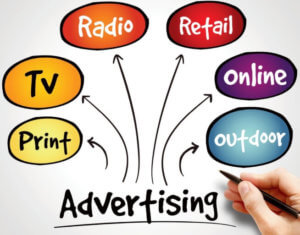Follow this step-by-step guide and make the most of your precious advertising dollars. (Spoiler alert: It’s all about audience)
 You are confident in your merchandising strategy, feel good about the skills of retail sales associates on your floor and know you are selling quality products that will help people sleep better and wake up feeling energized.
You are confident in your merchandising strategy, feel good about the skills of retail sales associates on your floor and know you are selling quality products that will help people sleep better and wake up feeling energized.
But if you are flummoxed, even frustrated, by how best to reach consumers to tell them all the great things about your store — and get them to buy your products — you are not alone.
When Sleep Savvy talked to Mattress Direct for this month’s Retail Road Trip , Lee Burns told us he’s constantly evaluating and shifting resources to create the right advertising program for the Baton Rouge, Louisiana-based chain of 25 sleep shops he founded and now co-owns with Ty Hingle. Right now, the retailer’s marketing strategy includes broadcast ads (including Pandora), some mailed inserts and a mix of digital efforts, from organic search to social media.
“If I tell you what’s working today, it might be different by the time the article comes out,” Burns told us. (For context, the time between interview and publication was about four months.)
Sleep Savvy has heard similar sentiments from other retailers. The media landscape has changed significantly in recent years. Major mattress brands have shifted their own marketing dollars away from co-op advertising that promoted both the manufacturers and retailers in favor of direct-to-consumer messaging. Traditional newspapers, magazines and broadcasters (both TV and radio) have gone out of business or lost audience — and audiences themselves have splintered, finding news, entertainment and information in countless media niches, many of them famously subscription based and ad free.
The consumers that mattress retailers want to reach are definitely online, but it’s a challenge to figure out how best to catch their attention, give them a reason to visit your store, browse your e-commerce site and, most importantly, make a purchase. And consumers themselves, inundated with everything from pop-up ads to promotional text messages, are tuning many marketing messages out.
All this makes efficient media planning and buying more important than ever. And now is a great time to assess your strategy. Soon you’ll have first-quarter numbers to assess and you still have plenty of time to tweak your plans for the remainder of 2019.
Here, we’ll walk you through some basics and give you resources for more information so you can make sure you’re spending your precious marketing dollars most effectively.
Start with a plan
Your media planning needs to begin with some good ol’ basic market research. Not sexy, but necessary. You can tackle this on your own or hire an agency, but either way, you’ll work through a similar process.
Start by deciding what you need your marketing campaign to accomplish, recommends Mediatool, a media planning firm with offices in the Swedish cities of Malmo and Stockholm. Do you want to create brand awareness? Sell more accessories? Grow traffic at a new location? Promote higher-end mattress sets? Capture more market share? Now is a good time to establish your overall budget, too.
“This prelaunch step should never be skipped. Without proper planning you will almost assuredly waste time and money upon execution,” writes Jenna Bruce in a November 2018 blog for Mediaspace, a media planning and buying firm with offices in New York and Minnetonka, Minnesota.
Once you have a clear idea of your goals, you need to better understand your market and the consumers you want to reach. For mattress retailers, this would include studying your geographic market, as well as the overall universe of mattress buyers; analyzing industry trends; and assessing your competition. You’ll also need to “identify target audiences and understand where those audiences are most engaged with ad content,” according to an April 2018 Mediatool article. “This is the stage where the marketer must unearth the nuances of a certain audience group and assess what their behaviors are, where they go for information, what products they care about and why, what media channels they are accessing throughout their day.”
Some good websites for tracking trends in consumer behavior and media consumption include:
- EMarketer.com
- IAB.com (also offers handy charts of standard ad sizes and guidelines for all major media types)
- MarketingCharts.com
- PewInternet.org
- Trends.Google.com
With that information in hand, you can better determine the right media mix, which is most likely going to include both traditional media (think billboards, TV ads, radio spots, direct mail) and digital media (from social media to podcasts to search engine marketing). At this stage, you’ll also want to decide how to divide up your overall budget.
Interestingly, in an April 2018 article for Total Retail, Marissa Tarleton points out that nine out of 10 retailers expected to increase their marketing spending “and marketers will spread their increased budget almost evenly among channels such as social, mobile, brand and display.” But notably, she writes, more have dedicated money to social media (78%) than to other media channels. Tarleton is chief marketing officer of RetailMeNot, a site that offers coupons, promo codes, sales, cash-back offers and gift card deals for retailers.
There’s no universal breakdown for retailers. According to Tarleton, you might put “50% toward social media, 25% in mobile ads, 10% in billboards, and the rest in radio,” while, for another retailer, a split of 30% social media, 30% print and 40% TV might make more sense.
Spend the money
Now it’s time to spend those marketing dollars. As with the media planning process, you can hire an agency to do media buying for you. In this phase, it can be especially beneficial to seek outside help because professional media buyers have not only the expertise but, ideally, well-established contacts with publishers, station owners and other media platforms that can help them negotiate better deals. Whether you go that route or handle it yourself, the basics of the process and decisions you’ll need to make are the same.
Depending on the size of your campaign budget and market, you may start by sending requests for proposals to media outlets. You’ll want to include information like expected run dates, target audience, geographic restrictions, special requests for placement, evaluation metrics, budget and a due date for them to get back to you. When you start receiving responses, the negotiating starts. Mediatool notes that if you hire out media buying, “It’s the media buyer’s job to do their best to secure that ad space and do it at — or below — the budgeted amount.”
One thing to consider, especially when buying on social media and other digital platforms, is if you want to target syndicated audiences or custom audiences, notes Lorel Wilhelm-Volpi, director of client strategy at SpotRight Inc., a media agency based in Little Rock, Arkansas.
Choosing a syndicated audience on a platform means you can narrow your target demographic using broad factors like gender, age, location and interests. This could allow you, for instance, to reach women ages 35 to 55 within 100 miles of your store who have an interest in health and wellness.
“The advantage in syndicated audiences is that they are fast and easy to use, and allow you to get started right away,” writes Wilhelm-Volpi in an August 2018 article. “The disadvantage … is that everyone else is pulling the same levers to target their campaign audiences, so you’re likely hitting people who are being bombarded with campaign after campaign.”
Custom audiences are, just like they sound, more highly targeted, based on metrics you determine will help you reach consumers most likely to be your customers.
“The advantage of going this route is that you’re not targeting the same people everyone else is targeting, and you’re probably hitting people who are more likely to become a customer,” Wilhelm-Volpi explains. “The downside? Time and money. It takes time (often several weeks if you use an outside service provider) to create the model and audiences, and that work is not done inexpensively. It can be a considerable investment.” Wilhelm-Volpi also notes that agencies like SpotRight have tools to combine the best of both worlds, creating custom segments more quickly and at less cost.
Another thing to consider: Whether you want to use programmatic advertising, which basically means using software to buy digital advertising, typically through one of the demand-side platforms that group the ad rates of various platforms. demand-side platforms and other ad networks include Google Display Network, Facebook Audience Network and The Trade Desk, Tarleton says.
Programmatic buying allows you to skip aspects of direct media buying like RFPs and negotiations. Proponents say it also allows companies to more precisely target audiences — and to do it more cheaply. But it has downsides, too, including the potential for fraudulent ad traffic and the risk of your ad appearing on a controversial program or platform.
“While programmatic buying is one of the fastest-growing areas of digital marketing, retail marketers have become keen on ensuring that their messages are reaching the right audience — i.e., one that’s likely to take action and make a purchase,” Tarleton says, adding that in an effort to get better traffic, more than six in 10 retailers planned to increase their direct media buys.
Final steps: You’re not quite done
FM radio may be giving way to podcasts and print ceding readers to digital, but the need to evaluate your marketing campaign hasn’t changed. One no-brainer step if you directly purchased ads: Make sure the spots and space you paid for ran as expected.
“You’ve got your brilliantly creative ad and you’ve got the perfect channel on which to deliver it. Now it’s time to monitor your placement to be sure it has aired according to the signed contract,” Bruce recommends. Then answer these big questions: “How did your ad perform? Did you achieve
the goals you set for yourself in your marketing plan? What could be adjusted to help the campaign perform better?”
The analytics tools of social media platforms will help with some of this. But, Wilhelm-Volpi, says, “Many ad platforms will only provide top-level reporting (impressions and clicks), which is why it’s important to couple this data with your Google Analytics.”
Mediatool advises creating a robust system for evaluation: “Whether you’re engaging in programmatic ad buying or manually bidding, it’s critical to have a platform where all of your media plans can live and be shared in real time; data from your ad performances can be consolidated; you can assess planned budget versus actual spend; (and) said data can be analyzed and formatted into easy-to-understand charts and graphs.” If you’re using an outside media buyer, they should have a tool that gathers all that information for your review. If not, you’ll need to come up with a way to collect and evaluate it.
Key questions to ask, Wilhelm-Volpi says, include:
- Which ads performed best?
- Which customer segments responded well?
- Which media sources/platforms converted best to customers (or website visitors, queries, etc.)?
- Which ad platforms generated the majority of traffic or customers?
“For example, you may find that Facebook ads convert more leads at a higher cost, while display ads through an ad network generate more traffic
at a lower conversion rate,” Wilhelm-Volpi says. “From here, you’d need to adjust based on your overall goals.”
 Finding Your Customers
Finding Your Customers
Part of media planning and buying is understanding how to reach consumers along the various points on their path to purchase, which itself has evolved from a fairly straightforward journey to a circuitous route with multiple on- and off-ramps. Read more about the consumers’ journey in the January/February Sleep Savvy cover story, “Understanding the Customer Journey.”
Make Your Media Buys More Cost-Effective
 Here are a couple of other strategies to keep in mind when trying to get more advertising value for your dollar. They come from Mediaspace Solutions, a media planning and buying firm with offices in New York and Minnetonka, Minnesota.
Here are a couple of other strategies to keep in mind when trying to get more advertising value for your dollar. They come from Mediaspace Solutions, a media planning and buying firm with offices in New York and Minnetonka, Minnesota.
- Make a commitment. Just like you, media representatives like to be able to plan ahead and value long-term clients, writes Jenna Bruce in a November 2018 Mediaspace blog. You’re likely to get a better deal in terms of rates and placement if you’re willing to commit to a contract or future spending.
- Don’t be afraid to ask for more. “Once you scratch the media rep’s back, make sure to get your back scratched by asking for some extras,” Bruce says. “For the same amount of money, your rep may be able to throw in more airtime, program sponsorships, content integration or something else. For instance, you could ask for your spot to be bumped to a better time slot to close the deal. It doesn’t really cost the sales rep anything to do this, and many will be open to it.”
“Alexa, Play My Ad”
 The smart speakers popping up in homes across the country might not be part of your marketing mix today, but they likely will be in the not-too-distant future.
The smart speakers popping up in homes across the country might not be part of your marketing mix today, but they likely will be in the not-too-distant future.
Estimates vary but indicate that between a quarter and a third of Americans already use a smart speaker like Apple HomePod, Amazon Alexa and Google Home, with the adoption rate growing quickly. And where there are listeners, there will be ads.
“We will likely see more and more online publications embrace voice and publish audio content to these devices,” according to an August 2018 article from Social Report, a New York-based company that provides social media management. “… Furthermore, we expect to see more ads on these platforms — after all, publications need to monetize content. Amazon, Google and Apple may very well launch their own advertising platforms for this, making it easier for companies to buy and sell ad space. Think Adwords but for your Google Home.”
LEARN MORE
 Can’t keep straight the difference between a CTR and a CPM? Mediatool, a media planning firm with offices in the Swedish cities of Malmo and Stockholm, has a handy glossary of terms you’re likely to encounter when media buying. (CTR, by the way, stands for “click-through rate,” a ratio comparing the number of people who see a digital ad to the number of people who click on it. CPM is an abbreviation for cost per thousand — “mille” is Latin for thousand — impressions and denotes the price you pay to reach 1,000 viewers or readers.)
Can’t keep straight the difference between a CTR and a CPM? Mediatool, a media planning firm with offices in the Swedish cities of Malmo and Stockholm, has a handy glossary of terms you’re likely to encounter when media buying. (CTR, by the way, stands for “click-through rate,” a ratio comparing the number of people who see a digital ad to the number of people who click on it. CPM is an abbreviation for cost per thousand — “mille” is Latin for thousand — impressions and denotes the price you pay to reach 1,000 viewers or readers.)
For a more detailed look at media buying, particularly in the digital realm, check out “How to Set Up Profitable and Scalable Media Buying Campaigns,” an August 2018 article by Lorel Wilhelm-Volpi, director of client strategy at SpotRight Inc., an agency based in Little Rock, Arkansas that specializes in consumer intelligence, audience targeting and marketing strategies.

Julie A. Palm is chief wordsmith at Palm Ink LLC in Winston-Salem, North Carolina. She has 25 years of experience as a writer and editor for newspapers and magazines and as a publications director. She is a past editor in chief of both Sleep Savvy and BedTimes magazines. She can be reached at japalm623@gmail.com.






